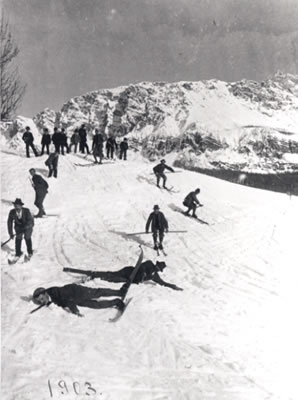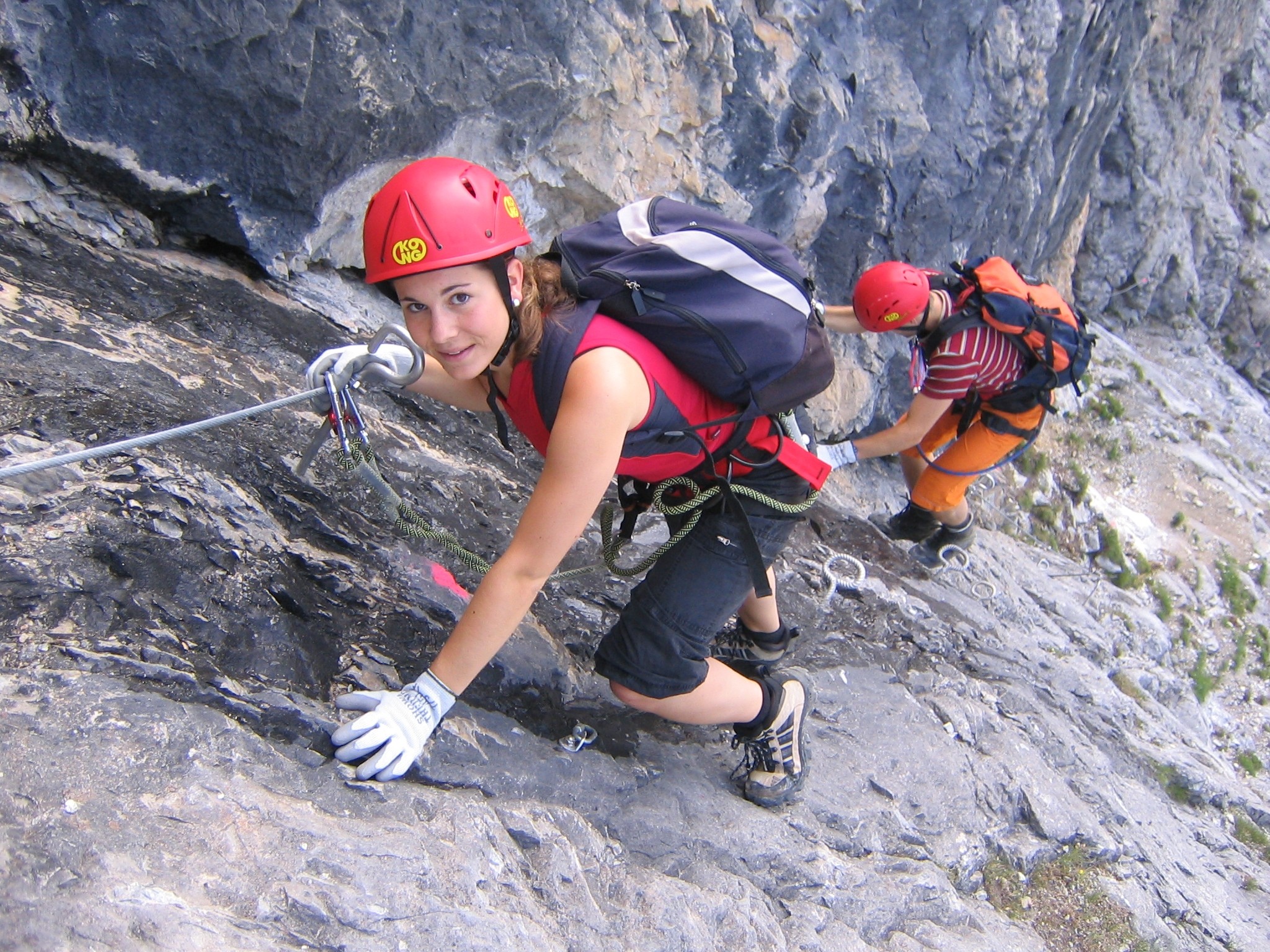|
Marmolada
Marmolada (Ladin language, Ladin: ''Marmolèda''; German language, German: ''Marmolata'', ) is a mountain in northeastern Italy and the highest mountain of the Dolomites (a section of the Alps). It lies between the borders of Trentino and Veneto. The Marmolada is an ultra-prominent peak (Ultra), known as the "Queen of the Dolomites". In 2009, as part of the Dolomites, the Marmolada massif was named a World Heritage Site, UNESCO World Heritage site. The largest glacier in the Dolomites, the Marmolada Glacier, is located on the northern face of the mountain. Geography The mountain is located about north-northwest of Venice, from which it can be seen on a clear day. It consists of a ridge running west to east. Towards the south it breaks suddenly into sheer cliffs, forming a rock face several kilometers long. On the north side, there is a comparatively flat glacier, the only large glacier in the Dolomites (the Marmolada Glacier, ''Ghiacciaio della Marmolada''). The ridge is c ... [...More Info...] [...Related Items...] OR: [Wikipedia] [Google] [Baidu] |
2022 Marmolada Serac Collapse
On 3 July 2022, a serac collapsed on the mountain of Marmolada, in the Dolomites at the regional border between Trentino and Veneto, Italy. Eleven people were killed and eight were wounded. The large-scale collapse of the serac led to one of the most serious accidents in the Alps in decades. The seismic energy released was comparable to an earthquake of 0.6 M. Background Prior to the collapse the area had seen an early heat wave, with the summit of the Marmolada recording abnormally high temperatures of around . The collapse occurred near Punta Rocca at a height of , on a route utilized by climbers to reach the top peak. Description On the afternoon of Sunday 3 July, around 13:45, a massive avalanche was triggered by a serac that collapsed due to the high temperatures, which reached 10 °C the day before the tragedy. At an elevation of 2800 metres, the lower end of a glacier snapped off. The break-off had a width of about 80 metres and a height of 25 metres. The detache ... [...More Info...] [...Related Items...] OR: [Wikipedia] [Google] [Baidu] |
Marmolada Glacier
The Marmolada Glacier () is located on the mountain Marmolada in the province of Belluno, Italy. Geography Marmolada Glacier is the only one in the Dolomites section of the Alps. During World War I World War I or the First World War (28 July 1914 – 11 November 1918), also known as the Great War, was a World war, global conflict between two coalitions: the Allies of World War I, Allies (or Entente) and the Central Powers. Fighting to ..., the front line between Austrian and Italian forces ran over Marmolada, and Austrian soldiers built quarters in glacier tunnels, forming an "ice city" of considerable size. A World War I museum, ''Museo della Grande Guerra in Marmolada'', is located in the valley below the glacier. Incidents On 3 July 2022, a serac collapse killed 11 mountaineers. References Glaciers of Italy Geography of Trentino Glaciers of the Alps Marmolada {{Italy-glacier-stub ... [...More Info...] [...Related Items...] OR: [Wikipedia] [Google] [Baidu] |
White Friday (1916)
White Friday was a series of avalanches on the Italian front of World War I. The most significant avalanche struck the Austro-Hungarian barracks on Mount Marmolada, killing 270 soldiers. Other avalanches on the same day would strike Italian and other Austro-Hungarian positions, killing hundreds. According to some reports, both sides deliberately fired shells into the weakened snowpacks in an attempt to bury the other side. An accurate estimation of the number of casualties from the White Friday avalanches is not available; historical documents suggest at least 2,000 soldier deaths and a few dozen civilians. Though the occurrence of avalanches in the Dolomites Mountains took place on a Wednesday in 1916, the term "White Friday" was used to coin the disastrous day, and the event is commemorated every year on 13 December, which is also marked by Saint Lucy's Day, a commemorative religious holiday practiced by the majority of Italian Catholics. Gran Poz summit Avalanches Th ... [...More Info...] [...Related Items...] OR: [Wikipedia] [Google] [Baidu] |
Dolomites
The Dolomites ( ), also known as the Dolomite Mountains, Dolomite Alps or Dolomitic Alps, are a mountain range in northeastern Italy. They form part of the Southern Limestone Alps and extend from the River Adige in the west to the Piave Valley ( Pieve di Cadore) in the east. The northern and southern borders are defined by the Puster Valley and the Sugana Valley (). The Dolomites are in the regions of Veneto, Trentino-Alto Adige/Südtirol and Friuli-Venezia Giulia, covering an area shared between the provinces of Belluno, Vicenza, Verona, Trentino, South Tyrol, Udine and Pordenone. Other mountain groups of similar geological structure are spread along the River Piave to the east—; and far away over the Adige River to the west—'' Dolomiti di Brenta'' (Western Dolomites). A smaller group is called (Little Dolomites), between the provinces of Trentino, Verona and Vicenza. The Dolomiti Bellunesi National Park and many other regional parks are in the Dolomites. On 26 J ... [...More Info...] [...Related Items...] OR: [Wikipedia] [Google] [Baidu] |
Via Ferrata
A via ferrata (Italian language, Italian for "iron path", plural ''vie ferrate'' or in English ''via ferratas'') is a protected climbing route found in the Alps and certain other Alpine locations. The protection includes steel fixtures such as cables and railings to arrest the effect of any fall, which the climber can either hold onto or Glossary of climbing terms#clip in, clip into using climbing protection. Some via ferratas can also include steel fixtures that provide aid climbing, aid in overcoming the obstacles encountered, including steel ladders and steel steps. Description A via ferrata is a climbing route in the mountains that employs steel cables, rungs, or ladders, fixed to the rock to which the climbers affix #Via ferrata set, a harness with two leashes, which allows the climbers to secure themselves to the metal fixture and limit any fall. The cable and other fixtures, such as iron rungs (stemples), pegs, carved steps, and ladders and bridges, provide both footing ... [...More Info...] [...Related Items...] OR: [Wikipedia] [Google] [Baidu] |
List Of Alpine Peaks By Prominence
This is a list of the mountains of the Alps, ordered by their topographic prominence. For a list by height, see the list of mountains of the Alps. By descending to 1,500 m of prominence, this list includes all the Ultras of the Alps. Some famous peaks, such as the Matterhorn and Eiger, are not Ultras because they are connected to higher mountains by high cols and therefore do not achieve enough topographic prominence. Where the '' prominence parent'' and the '' island parent'' differ, the prominence parent is marked with "1" and the island parent with "2" (with Mont Blanc abbreviated to ''MB''). The column "Col height" denotes the lowest elevation to which one must descend from a peak in order to reach peaks with higher elevations; note that the elevation of any peak is the sum of its prominence and col. The column "Col location" denotes the pass where the col height is located. See also * Worldwide list of peaks ranked by prominence * List of mountains of Switzerland (with he ... [...More Info...] [...Related Items...] OR: [Wikipedia] [Google] [Baidu] |
Beatrice Tomasson
Beatrice Tomasson (25 April 1859 – 13 February 1947) was an English mountaineer. She climbed extensively in the Dolomites and made the first ascent of the south face of the Marmolada in 1901. Biography Early life Beatrice Tomasson was born in 1859 to William and Sarah Anne Tomasson, in Barnby Moor, Nottinghamshire; she was their second child. At ten years old, Tomasson and her family moved to Ireland. They lived in Gortnamona, a property near Tullamore, County Offaly. In 1882, when she was 22 years old, Tomasson travelled to Potsdam, then part of Prussia, to work as a private tutor for the household of Prussian army General von Bülow. Unsuccessfully, she tried to translate and publish Felix Dahn's four-volume novel '' A Struggle for Rome'' from German to English. She and Cäcilie Wüstenburg later wrote and translated ''The Chimes of Erfurt: A Tale'', which was published in 1885. Mountaineering Tomasson moved to Innsbruck in 1885 where she took up mountain climbing. From 18 ... [...More Info...] [...Related Items...] OR: [Wikipedia] [Google] [Baidu] |
List Of Mountains Of The Alps Above 3000 M
This page tabulates only the most prominent mountains of the Alps, selected for having a topographic prominence of ''at least'' , all exceeding in height. Although the list contains 537 summits, some significant alpine mountains are necessarily excluded for failing to meet the stringent prominence criterion. The list of these most prominent mountains is continued down to 2500 m elevation at List of prominent mountains of the Alps (2500–2999 m) and down to 2000 m elevation on List of prominent mountains of the Alps (2000–2499 m). All such mountains are located in France, Italy, Switzerland, Liechtenstein, Austria, Germany or Slovenia, even in some lower regions. Together, these lists include all 44 List of Alpine peaks by prominence, ultra-prominent peaks of the Alps, with 19 ultras over 3000m on this page. For a definitive list of all 82 of the highest peaks of the Alps, as identified by the International Climbing and Mountaineering Federation (UIAA), and often referred to ... [...More Info...] [...Related Items...] OR: [Wikipedia] [Google] [Baidu] |
Hansjörg Auer
Hansjörg Auer (; 18 February 1984 – 16 April 2019) was an Austrian mountaineer, noted for his free solo climbs, and particularly of ''Fish Route'' in the Italian Dolomites, the first-ever big wall solo at . ''National Geographic'' described him as "one of the boldest and best climbers in the world", and he won the 2019 Piolet d'Or for this free solo ascent of the Lupghar Sar West, in northern Pakistan. He died in an avalanche while climbing on Howse Peak in the Canadian Rockies. Personal life Auer was born in Zams, Tyrol, on 18 February 1984, and lived in the Ötztal area of Tyrol. In 2017, he published an autobiography entitled ''Südwand'', in which he describes his problems with anorexia. He considered the South Tyrolean alpinist Reinhold Messner to be a role model. Career Auer's first major free solo climb was ''Tempi Moderni'' ("Modern Times"), an route of 27 pitches graded , on the south face of Marmolada in the Dolomites in northeastern Italy, which he climbed ... [...More Info...] [...Related Items...] OR: [Wikipedia] [Google] [Baidu] |
Trentino
Trentino (), officially the Autonomous Province of Trento (; ; ), is an Autonomous province#Italy, autonomous province of Italy in the Northern Italy, country's far north. Trentino and South Tyrol constitute the Regions of Italy, region of Trentino-Alto Adige/Südtirol, an autonomous region under the constitution. The province is composed of 166 ''comuni'' (: ''comune''). Its capital is the city of Trento (Trent). The province covers an area of more than , with a total population of 541,098 in 2019. Trentino is renowned for its Mountain, mountains, such as the Dolomites, which are part of the Alps. Etymology The province is generally known as "Trentino". The name derives from Trento, the capital city of the province. Originally, the term was used by the local population only to refer to the city and its immediate surroundings. Under former Austrian Empire, Austrian rule, which began in the 19th century (previously, Trentino was governed by the local bishop), the common German ... [...More Info...] [...Related Items...] OR: [Wikipedia] [Google] [Baidu] |
Alps
The Alps () are some of the highest and most extensive mountain ranges in Europe, stretching approximately across eight Alpine countries (from west to east): Monaco, France, Switzerland, Italy, Liechtenstein, Germany, Austria and Slovenia. The Alpine arch extends from Nice on the western Mediterranean Sea, Mediterranean to Trieste on the Adriatic Sea, Adriatic and Vienna at the beginning of the Pannonian Basin. The mountains were formed over tens of millions of years as the African and Eurasian tectonic plates collided. Extreme shortening caused by the event resulted in marine sedimentary rocks rising by thrust fault, thrusting and Fold (geology), folding into high mountain peaks such as Mont Blanc and the Matterhorn. Mont Blanc spans the French–Italian border, and at is the highest mountain in the Alps. The Alpine region area contains 82 peaks higher than List of Alpine four-thousanders, . The altitude and size of the range affect the climate in Europe; in the mountain ... [...More Info...] [...Related Items...] OR: [Wikipedia] [Google] [Baidu] |






